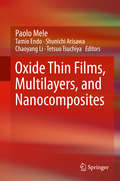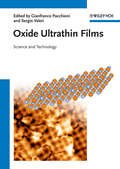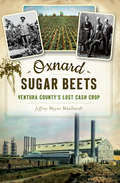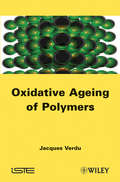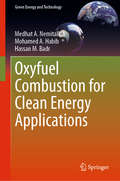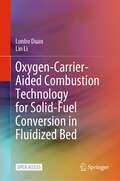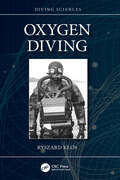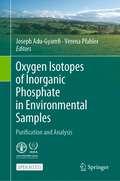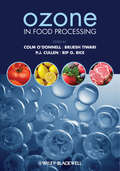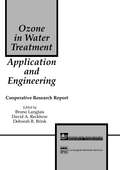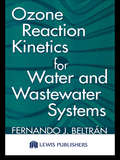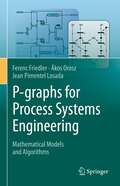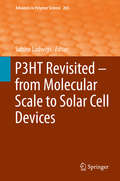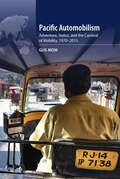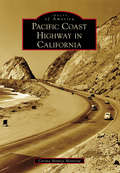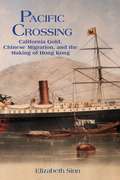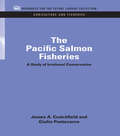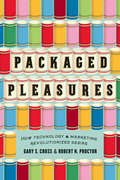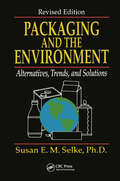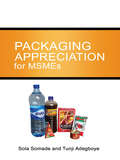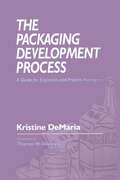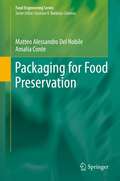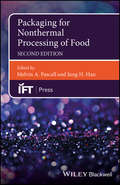- Table View
- List View
Oxide Thin Films, Multilayers, and Nanocomposites
by Paolo Mele Tamio Endo Shunichi Arisawa Chaoyang Li Tetsuo TsuchiyaThis book provides a comprehensive overview of the science of nanostructured oxides. It details the fundamental techniques and methodologies involved in oxides thin film and bulk growth, characterization and device processing, as well as heterostructures. Both, experts in oxide nanostructures and experts in thin film heteroepitaxy, contribute the interactions described within this book.
Oxide Ultrathin Films
by Sergio Valeri Gianfranco PacchioniA wealth of information in one accessible book. Written by international experts from multidisciplinary fields, this in-depth exploration of oxide ultrathin films covers all aspects of these systems, starting with preparation and characterization, and going on to geometrical and electronic structure, as well as applications in current and future systems and devices.From the Contents:Synthesis and Preparation of Oxide Ultrathin FilmsCharacterization Tools of Oxide Ultrathin FilmsOrdered Oxide Nanostructures on Metal SurfacesUnusual Properties of Oxides and Other Insulators in the Ultrathin LimitSilica and High-K Dielectrics Thin Films in MicroelectronicsOxide Passive Films and Corrosion ProtectionOxide Films as Catalytic Materials and as Models of Real CatalystsOxide Films in SpintronicsOxide Ultrathin Films in Solid Oxide Fuel CellsTransparent Conducting and Chromogenic Oxide Films as Solar Energy MaterialsOxide Ultrathin Films in Sensor ApplicationsFerroelectricity in Ultrathin Film CapacitorsTitania Thin Films in Biocompatible Materials and Medical ImplantsOxide Nanowires for New Chemical Sensor Devices
Oxnard Sugar Beets: Ventura County's Lost Cash Crop (Lost)
by Jeffrey Wayne MaulhardtIn the early 1890s, farmers Albert Maulhardt and John Edward Borchard discovered Ventura County's favorable conditions for a highly profitable new cash crop: the sugar beet. Not long after inviting sugar mogul Henry T. Oxnard to the area, construction began on a $2 million sugar factory capable of processing two thousand tons of beets daily. The facility brought jobs, wealth and the Southern Pacific rail line. It became one of the country's largest producers of sugar, and just like that, a town was born. Despite the industry's demise, the city of Oxnard still owes its name to the man who delivered prosperity. A fifth-generation descendant, local author and historian Jeffrey Wayne Maulhardt details the rise and fall of a powerful enterprise and the entrepreneurial laborers who helped create a city.
Oxydative Ageing of Polymers
by Jacques VerduThis book aims to rehabilitate kinetic modeling in the domain of polymer ageing, where it has been almost abandoned by the research community. Kinetic modeling is a key step for lifetime prediction, a crucial problem in many industrial domains in which needs cannot be satisfied by the common empirical methods.The book proposes a renewed approach of lifetime prediction in polymer oxidative ageing. This approach is based on kinetic models built from relatively simple mechanistic schemes but integrating physical processes (oxygen diffusion and stabilizer transport), and use property (for instance mechanical failure) changes. An important chapter is dedicated to radiation-induced oxidation and its most important applications: radiochemical ageing at low dose rates and photo-chemical ageing under solar radiation. There is also a chapter devoted to the problem of ageing under coupled oxidation and mechanical loading.
Oxyfuel Combustion for Clean Energy Applications (Green Energy and Technology)
by Hassan M. Badr Mohamed A. Habib Medhat A. NemitallahThis book aims to be the reference book in the area of oxyfuel combustion, covering the fundamentals, design considerations and current challenges in the field. Its first part provides an overview of the greenhouse gas emission problem and the current carbon capture and sequestration technologies. The second part introduces oxy-fuel combustion technologies with emphasis on system efficiency, combustion and emission characteristics, applications and related challenges. The third part focuses on the recent developments in ion transport membranes and their performance in both oxygen separation units and oxygen transport reactors (OTRs). The fourth part presents novel approaches for clean combustion in gas turbines and boilers. Computational modelling and optimization of combustion in gas turbine combustors and boiler furnaces are presented in the fifth part with some numerical results and detailed analyses.
Oxygen-Carrier-Aided Combustion Technology for Solid-Fuel Conversion in Fluidized Bed
by Lunbo Duan Lin LiThis open access book surveys the development of OCAC technology in the last decade for solid fuel conversion in fluidized beds. The scientific concerns, including combustion and emission characteristics, ash-related problems, OC aging, and so on, are summarized and analyzed. Beyond this, new concepts like OCAC with Oxy-PFBC, OCAC coupled with staged fuel conversion, OCAC in rotatory kilns and multi-functional OCAC are proposed, so as to promote the applications of OCAC to various fields in the future. Moreover, this book also outlines the perspectives for future research and development of OCAC. As an emerging technology, extensive studies and investigations are still necessary to fill in the gap from the fundamental understanding of the technology to its industrial demonstrations. Nevertheless, we believe that this book provides novel insights for the readership of energy and combustion and stimulate meaningful follow-on research on OCAC technology.
Oxygen Diving (Diving Sciences)
by Ryszard KlosThe book provides a derivation of the models used for calculating the risk and hazard of central oxygen toxicity pertaining to diving-based studies consistent with the research conducted earlier by the Royal Navy and the US Navy. This book forms the basis for extending the possibility of undertaking nitrox dives in combination with oxygen dives, thus significantly increasing tactical capabilities of conducting diving special operations. Features: provides derivation of the models used for calculating the risk and hazard of central oxygen toxicity improves oxygen diving procedures described in the US Navy Diving Manual includes procedures applicable to undertaking nitrox dives in combination with oxygen dives pitches the material at highest technology readiness levels, i.e. 9 TRL aims to increase tactical capabilities of conducting diving special operations This book is aimed at researchers, professionals and graduate students in life support system design, diving submarine safety, ventilation, health, sanitary engineering, mining engineering and working environment in chambers or closed compartments.
Oxygen Isotopes of Inorganic Phosphate in Environmental Samples: Purification and Analysis
by Joseph Adu-Gyamfi Verena PfahlerThis open access book distinguished itself from other publications by offering step-by-step instructions on how to extract, purify, provide modifications, and major issues to be encountered during the process. For the δ18OP method to progress, further fundamental research as well as field and laboratory studies need to be conducted for a better understanding of P cycling in the environment. Chapter 1 outlines the background and examples of δ18Op studies in sediments, soils, fresh water, mineral fertilizers, and plants. Chapters 2 and 3 examine the stepwise extraction and purification protocols including reagents, equipment and consumables and preparations for analyses. Chapter 4 examines some of the challenges and modifications during the purification process. Chapter 5 discusses planning and designing of a study using δ18Op, external quality assurance with an example of an inter-laboratory study. Chapter 6 outlines the conclusions, future trends, and opportunities, the scaling out of the method from laboratory to field studies. It is expected that the δ18OP would be extensively applied in research geared to understand phosphorus dynamics in different agro-environments.
Ozone in Food Processing
by Colm O’Donnell B. K. Tiwari P. J. Cullen Rip G. RiceThis book is the first to bring together essential information on the application of ozone in food processing, providing an insight into the current state-of-the-art and reviewing established and emerging applications in food processing, preservation and waste management. The chemical and physical properties of ozone are described, along with its microbial inactivation mechanisms. The various methods of ozone production are compared, including their economic and technical aspects. Several chapters are dedicated to the major food processing applications: fruit and vegetables, grains, meat, seafood and food hydrocolloids, and the effects on nutritional and quality parameters will be reviewed throughout. Further chapters examine the role of ozone in water treatment, in food waste treatment and in deactivating pesticide residues. The international regulatory and legislative picture is addressed, as are the health and safety implications of ozone processing and possible future trends.
Ozone in Water Treatment: Application and Engineering
by Bruno Langlais David A. Reckhow Deborah R. BrinkWith the advent of the Safe Drinking Water Act Amendments of 1986, many water utilities are reexamining their water treatment practices. Upcoming new regulations on disinfection and on disinfection by-products, in particular, are the primary driving forces for the big interest in ozone. It appears that ozone, with its strong disinfection capabilities, and apparently lower levels of disinfection by-products (compared to other disinfectants), may be the oxidant/disinfectant of choice. Many utilities currently using chlorine for oxidation may need to switch due to chlorine by-product concerns. Utilities using chloramines may need to use ozone to meet CT requirements. This book, prepared by 35 international experts, includes current technology on the design, operation, and control of the ozone process within a drinking water plant. It combines almost 100 years of European ozone design and operating experience with North American design/operations experience and the North American regulatory and utility operational environment. Topics covered include ozone chemistry, toxicology, design consideration, engineering aspects, design of retrofit systems, and the operation and economics of ozone technology. The book contains a "how to" section on ozone treatability studies, which explains what information can be learned using treatability studies, at what scale (bench, pilot, or demonstration plant), and how this information can be used to design full-scale systems. It also includes valuable tips regarding important operating practices, as well as guidance on retrofits and the unique issues involved with retrofitting the ozone process.With ozone being one of the hottest areas of interest in drinking water, this book will prove essential to all water utilities, design engineers, regulators, and plant managers and supervisors.
Ozone Reaction Kinetics for Water and Wastewater Systems
by Fernando J. BeltranThis text compiles information about ozonation kinetics of compounds for water and wastewater treatment professionals in a single volume. Application of kinetics to the evaluation, design, and implementation of ozone technology is discussed, along with information to determine when to use ozone treatments, and how to design effective systems. The book is divided into seven themes including: classification and studies on the kinetics of ozone direct reactions in water and wastewater; the determination of ozone rate coefficient (or reactivity quantification) in wastewater, according to the COD level, and the effects on biodegradability; and the kinetic modeling of the ozonation of water and wastewaters.
P-graphs for Process Systems Engineering: Mathematical Models and Algorithms
by Ferenc Friedler Ákos Orosz Jean Pimentel LosadaThis book discusses the P-graph framework for developing and understanding effective design tools for process systems engineering, and addresses the current state of its theory and applications. The book details the new philosophy of the axioms-based mathematical modelling of processing systems, the basic algorithms, areas of application, future directions, and the proofs of theorems and algorithms. Because of the rigorous foundation of the theory, the framework provides a firm basis for future research in mathematical modelling, optimization, and design of complex engineering systems. The various P-graph applications discussed include process network synthesis, reliability engineering, and systems resilience. The framework opens new avenues for research in complex systems including redundant operations for critical infrastructure, systems sustainability, and modelling tools for disaster engineering. Demonstration software is provided to facilitate the understanding of the theory. The book will be of interest to institutions, companies, and individuals performing research and R&D in process systems engineering.
A & P Technician Powerplant Textbook
by JeppesenThe lack of efficient and practical powerplants has limited aircraft development throughout history. For example, in 1483 Leonardo daVinci conceived a flying machine he called the aerial screw. However, without a powerplant, the aerial screw was never developed.
P3HT Revisited - From Molecular Scale to Solar Cell Devices
by Sabine LudwigsThe series Advances in Polymer Science presents critical reviews of the present and future trends in polymer and biopolymer science. It covers all areas of research in polymer and biopolymer science including chemistry, physical chemistry, physics, material science. The thematic volumes are addressed to scientists, whether at universities or in industry, who wish to keep abreast of the important advances in the covered topics. Advances in Polymer Science enjoys a longstanding tradition and good reputation in its community. Each volume is dedicated to a current topic, and each review critically surveys one aspect of that topic, to place it within the context of the volume. The volumes typically summarize the significant developments of the last 5 to 10 years and discuss them critically, presenting selected examples, explaining and illustrating the important principles, and bringing together many important references of primary literature. On that basis, future research directions in the area can be discussed. Advances in Polymer Science volumes thus are important references for every polymer scientist, as well as for other scientists interested in polymer science - as an introduction to a neighboring field, or as a compilation of detailed information for the specialist. Review articles for the individual volumes are invited by the volume editors. Single contributions can be specially commissioned. Readership: Polymer scientists, or scientists in related fields interested in polymer and biopolymer science, at universities or in industry, graduate students
Pacific Automobilism: Adventure, Status and the Carnival of Mobility, 1970–2015
by Gijs MomThe beginning of the 21st century has seen important shifts in mobility cultures around the world, as the West’s media-driven car culture has contrasted with existing local mobilities, from rickshaws in India and minibuses in Africa to cycling in China. In this expansive volume, historian Gijs Mom explores how contemporary mobility has been impacted by social, political, and economic forces on a global scale, as in light of local mobility cultures, the car as an ‘adventure machine’ seems to lose cultural influence in favor of the car’s status character.
Pacific Coast Highway in California (Images of America)
by Carina Monica MontoyaMore commonly known as Pacific Coast Highway, State Route 1 ribbons along or near the Pacific Ocean from Northern California at Leggett in Mendocino down to Southern California at San Juan Capistrano in Orange County. Its construction began in 1913 and was done incrementally, largely because of funding issues, shortage of labor, legal challenges, deep canyons, steep mountains, solid rock, and unstable earth. A true modern marvel, its unique and extraordinary construction allows easy access to some of the country's most famous and historical places and picturesque sights. Thousands of pounds of dynamite were used to blast through granite, marble, and sandstone to build a highway following near or along the coastline. Among the 33 bridges along the route is the remarkable Bixby (Rainbow) Bridge at Big Sur. The highway wends its way through some of the most magnificent and scenic landscapes and historical places found between Ventura and Humboldt Counties, making it more than just a road. It is a destination.
Pacific Crossing
by Elizabeth SinnDuring the nineteenth century tens of thousands of Chinese men and women crossed the Pacific to work, trade, and settle in California. Drawn initially by the gold rush, they took with them skills and goods and a view of the world which, though still Chinese, was transformed by their long journeys back and forth. They in turn transformed Hong Kong, their main point of embarkation, from a struggling infant colony into a prosperous international port and the cultural center of a far-ranging Chinese diaspora. Making use of extensive research in archives around the world, Pacific Crossing charts the rise of Chinese Gold Mountain firms engaged in all kinds of transpacific trade, especially the lucrative export of prepared opium and other luxury goods. Challenging the traditional view that the migration was primarily a "coolie trade," Elizabeth Sinn uncovers leadership and agency among the many Chinese who made the crossing. In presenting Hong Kong as an "in-between place" of repeated journeys and continuous movement, Sinn also offers a fresh view of the British colony and a new paradigm for migration studies.
The Pacific Northwest Coast: Living with the Shores of Oregon and Washington
by Paul D. KomarWhile the coast of the Pacific Northwest becomes populated with houses, condominiums, motels, and restaurants, its beaches and cliffs continue to be altered by ocean currents and winter storms. A companion volume to Living with the Shore of Puget Sound and the Georgia Strait, The Pacific Northwest Coast serves as a source of information about the coast of the Pacific Northwest, its geological setting, the natural responses of beaches and cliffs to ocean processes, and the ever-present problem of erosion.In this guide, Paul D. Komar, one of the nation's leading coastal oceanographers, examines the lessons taught by ages of geological and cultural history. With explanations of the area's geological evolution, including natural shoreline erosion and sea-cliff landsliding, Komar details human interaction with the coast: erosion caused by early settlers, the development and destruction of Bayocean Spit, the disastrous effects caused by the 1982-1983 El Niño, and the notorious failure of a construction project on the picturesqueæbut unstableæbluffs at Jump-Off Joe. Emphasizing the actual and potential harm to human projects and to the natural heritage of the coast, Komar provides the knowledge necessary for finding a safe home near the shore while preserving the beauty that draws us to it.
The Pacific Salmon Fisheries: A Study of Irrational Conservation (RFL Agriculture and Fisheries #3)
by James A. Crutchfield Giulio PontecorvoThis study attributes the chronic economic distress of the valuable Pacific salmon industry not only to decline in catch but also to the economic problems of open access ocean fisheries. It analyzes salmon public management programs and proposes alternatives. Originally published in 1969
Packaged Pleasures: How Technology & Marketing Revolutionized Desire
by Gary S. Cross Robert N. ProctorFrom the candy bar to the cigarette, records to roller coasters, a technological revolution during the last quarter of the nineteenth century precipitated a colossal shift in human consumption and sensual experience. Food, drink, and many other consumer goods came to be mass-produced, bottled, canned, condensed, and distilled, unleashing new and intensified surges of pleasure, delight, thrill--and addiction. In Packaged Pleasures, Gary S. Cross and Robert N. Proctor delve into an uncharted chapter of American history, shedding new light on the origins of modern consumer culture and how technologies have transformed human sensory experience. In the space of only a few decades, junk foods, cigarettes, movies, recorded sound, and thrill rides brought about a revolution in what it means to taste, smell, see, hear, and touch. New techniques of boxing, labeling, and tubing gave consumers virtually unlimited access to pleasures they could simply unwrap and enjoy. Manufacturers generated a seemingly endless stream of sugar-filled, high-fat foods that were delicious but detrimental to health. Mechanically rolled cigarettes entered the market and quickly addicted millions. And many other packaged pleasures dulled or displaced natural and social delights. Yet many of these same new technologies also offered convenient and effective medicines, unprecedented opportunities to enjoy music and the visual arts, and more hygienic, varied, and nutritious food and drink. For better or for worse, sensation became mechanized, commercialized, and, to a large extent, democratized by being made cheap and accessible. Cross and Proctor have delivered an ingeniously constructed history of consumerism and consumer technology that will make us all rethink some of our favorite things.
Packaging and the Environment: Alternatives, Trends and Solutions
by Susan SelkeThe leading book on packaging and the environment-now expanded and updated This is a detailed examination and objective analysis of all aspects of environmental problems related to packaging: resource depletion, pollution, solid waste management, recycling, degradability, package design considerations, and legislation. The author is a leading authority on the subject. The presentation is well documented and non-partisan. This new edition is expanded and completely updated.
Packaging Appreciation for MSMEs
by Sola Somade Tunji AdegboyeThis is a packaging technology book written with utmost simplicity to acquaint the manufacturers of products (foods, drinks, general goods, etc.) within the MSME operators of the critical role of packaging in the successful marketing of their products. The role of packaging (containment, protection, preservation and sales) is discussed. The objective of the book is to enlighten the MSMEs on how to choose a packaging that works, that is, one that will protect and sell their products. Various options of packaging materials and their characteristics are discussed. Consequences of packaging failures and how to avoid them are contained in the book. It is a book that is recommended for all who have products to market within the MSME operators as well as non-packaging professionals who want to know about packaging. It is a good reference book for packaging professionals and students of packaging technology.
The Packaging Development Process: A Guide for Engineers and Project Managers
by Kristine DeMariaThe Packaging Development Process: A Guide for Engineers and Project Managers presents the techniques necessary for creating, testing, and launching packaging, in one convenient reference book. It does so by explaining each step of how a packaging project evolves from the business plan to product launch, with an emphasis on the financial and human
Packaging for Food Preservation
by Amalia Conte Matteo Alessandro Del NobileThe book will be focused on the three most important aspects of food packaging: Modeling, Materials and Packaging Strategies. The modeling section will provide a complete overview of mass transport phenomena in polymers intended for food packaging applications. The materials section will cover the most interesting problem-solving solutions in the field of food packaging, i.e., low environmental impact active films with antimicrobial activity. Lastly, the packaging section will provide an overview of the most recent approaches used to prolong the shelf life of several food products.
Packaging for Nonthermal Processing of Food (Institute of Food Technologists Series #28)
by Melvin A. Pascall Jung H. HanA comprehensive review of the many new developments in the growing food processing and packaging field Revised and updated for the first time in a decade, this book discusses packaging implications for recent nonthermal processing technologies and mild food preservation such as high pressure processing, irradiation, pulsed electric fields, microwave sterilization, and other hurdle technologies. It reviews typical nonthermal processes, the characteristics of food products after nonthermal treatments, and packaging parameters to preserve the quality and enhance the safety of the products. In addition, the critical role played by packaging materials during the development of a new nonthermal processed product, and how the package is used to make the product attractive to consumers, is discussed. Packaging for Nonthermal Processing of Food, Second Edition provides up to date assessments of consumer attitudes to nonthermal processes and novel packaging (both in the U.S. and Europe). It offers a brand new chapter covering smart packaging, including thermal, microbial, chemical, and light sensing biosensors, radio frequency identification systems, and self-heating and cooling packaging. There is also a new chapter providing an overview of packaging laws and regulations in the United States and Europe. Covers the packaging types required for all major nonthermal technologies, including high pressure processing, pulsed electric field, irradiation, ohmic heating, and others Features a brand new chapter on smart packaging, including biosensors (thermal-, microbial-, chemical- and light-sensing), radio frequency identification systems, and self-heating and cooling packaging Additional chapters look at the current regulatory scene in the U.S. and Europe, as well as consumer attitudes to these novel technologies Editors and contributors bring a valuable mix of industry and research experience Packaging for Nonthermal Processing of Food, Second Edition offers many benefits to the food industry by providing practical information on the relationship between new processes and packaging materials, to academia as a source of fundamental knowledge about packaging science, and to regulatory agencies as an avenue for acquiring a deeper understanding of the packaging requirements for new processes.
